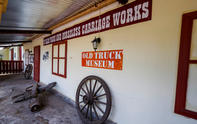Historic Architecture
The best way to explore the history of Loxton is on foot. Take in fine examples of architecture, like the old jail which dates back to 1900. The hoëstoep-huisie is also a great example of a Karoo-style building.

A lot of buildings have historical and contextual importance in Loxton due to its early twentieth-century architecture. Wooden fretwork and various styles of corrugated iron roofs can still be seen, as well as classical pillars and balustrades.
Just outside Loxton there is a privately owned replica of a beautiful Dutch Castle, built in the 1970’s by Jan Hugo. He had always wanted to live in a castle and he would fly back and forth between Loxton and Holland to ensure he got the details of the castle perfect. The result was a three-storey castle with turrets, inverted cones and crenellated parapets.
Small Settlement
Historically, the town was founded in 1899 on the farm Phizantefontein, when the Dutch Reformed Church purchased the ground from the owner, one A. E. Loxton. A parish was established in Loxton to relieve the strain on the Victoria West parish, which was bursting at the seams with church-goers. This meant farmers in the local surrounds did not have to travel eight hours by horse every Sunday anymore. The first church building was completed in 1900 as well as the first school.
A dam was completed in 1912 to supply water to the town, but in 1961, heavy rains caused flooding that resulted in the collapse of the dam wall. Ironically, nearly three-quarters of the town was destroyed when a flash-flood broke through a dam wall above the town. Many historic houses and buildings sustained flood damage and had to be restored/renovated.
The town has recovered since then, it seems, and life these days continues at a rather unhurried pace. The stately Dutch Reformed Church that stands today in the centre of the town was built in 1924.